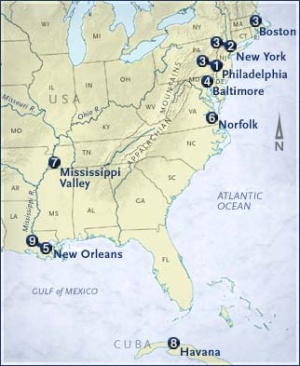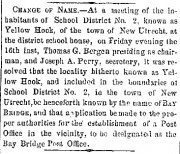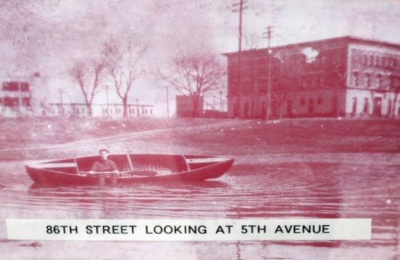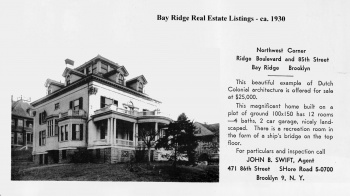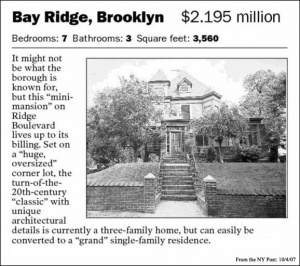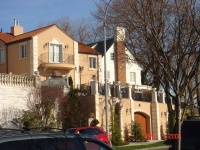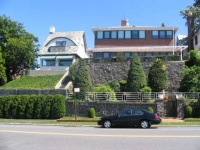Yellow Fever in Bay RidgeFrom The Peopling of New York City
Yellow Fever Epidemic in the United StatesNew Orleans circa 1817-1905 It is estimated that around 41,000 people died in the scourge of Yellow Fever in New Orleans between 1817 and 1905 (Crescent City's last epidemic). The year of 1853 was by far the worst, resulting in 7949 deaths. The first cases of Yellow fever appeared in early May of that year, but people thought nothing of it and the news of the epidemic were concealed to prevent damage to Real Estate. By mid-July, the epidemic became obvious and set the city into panic as more and more people were dying each day. The environmental conditions contributed to the spread of the sickness: high temperatures, humidity, lack of ozone in the air, and mosquitoes. Efforts were made to purify the atmosphere by firing six-hundred discharges from cannons. Alas, that only lead to more deaths as the sick went into convulsions. On August 4,1905, Theodore Roosevelt assigned Walter Wyman on a public health campaign to fight the mosquitos. Workers fumigated the city, screened cisterns and destroyed breeding grounds for mosquitoes. Fines were instituted against residents who failed to comply with public health measures.By October of 1905, the epidemic had ended.
Yellow Fever Hits Bay Ridge
The Birth of Bay Ridge: December 16, 1853Bay Ridge began life as Yellow Hook, a reflection of the yellow soil that used to cover the land in the 17th century. While its neighbor to the north, Red Hook, kept its colorful name, Yellow Hook became Bay Ridge when yellow fever swept the country in mid-19th century. After Yellow Fever broke out in the 1790’s and mid-1800’s, however, locals became worried that the name “Yellow Hook” would be associated with the disease and consequently would stunt development in the area. Efforts to save Yellow Hook were put forth by a group of men some of whom had established the Christ Church in 1851, at the corner of what is now 68th St. and Third Avenue. On December 16, 1853, these men, including Joseph A. Perry, Benjamin Townsend, William C. Langley, and James Weir, formed "The Ovington Village Association" and held a meeting at the School District No.2
schoolhouse (then on 3rd Avenue near 73rd St.) in order to come up with a new name for Yellow Hook. James Weir proposed the name of Bay Ridge, inspired by a ridge running along what is now Ridge Boulevard (then 2nd avenue). By simple decision, the group approved of the name and “Yellow Hook” was officially renamed “Bay Ridge.” It applied to a territory running from Sixty-first Street, the New Utrecht town line to about Eighty-sixth Street, and to Stewart Avenue, now Sixth Avenue and New York Bay.
The AftermathOverall, it seemed Weir and the rest of the council made the right decision in changing the name to Bay Ridge, as the influx of diverse people into the area is what shaped it into the city it is today. By 1860, 266,661 people lived in Brooklyn, by 1870, that number climbed to nearly 400,000[1]. The farmland by then had decreased to only 384 acres as manufacturing began to take its place. The farm laborers, mostly poor Irish, began to shrink and diversify. In 1860, 63% of farm laborers from Kings County were Irish, 490 of the total 778. Yet by 1870, only 38% were Irish, with whites and Germans each becoming 22% of the total, which now shrunk to only 648. Property value, however, wasn’t the only thing that boomed. Manufacturing also rose tremendously during these 10 years. While rural Kings County began to shrink, Brooklyn as a whole faced nearly a 200% increase across the board for number of establishments, value of products, employees, and wages. In 1880, Brooklyn had 5,201 manufacturing establishments with 47,587 employees who earned a total of $22,487,457. The value of their total output was $177,223,142. Yet by 1890, Brooklyn had 10,583 establishments with 109,292 employees that earned over 3x they did before—a total of $65,247,119. The total value of outputs increased, too, to a whopping $269,244,147. The number of farms also decreased, from 409 in 1879 (after a small boom) to 307 in 1890. Clearly, Bay Ridge was going places. The following is a look at the overall changes Bay Ridge has made from Yellow Hook in 1853 to the busy city it is now. Landscape
Real Estate
To the Bay Ridge homepage. |
